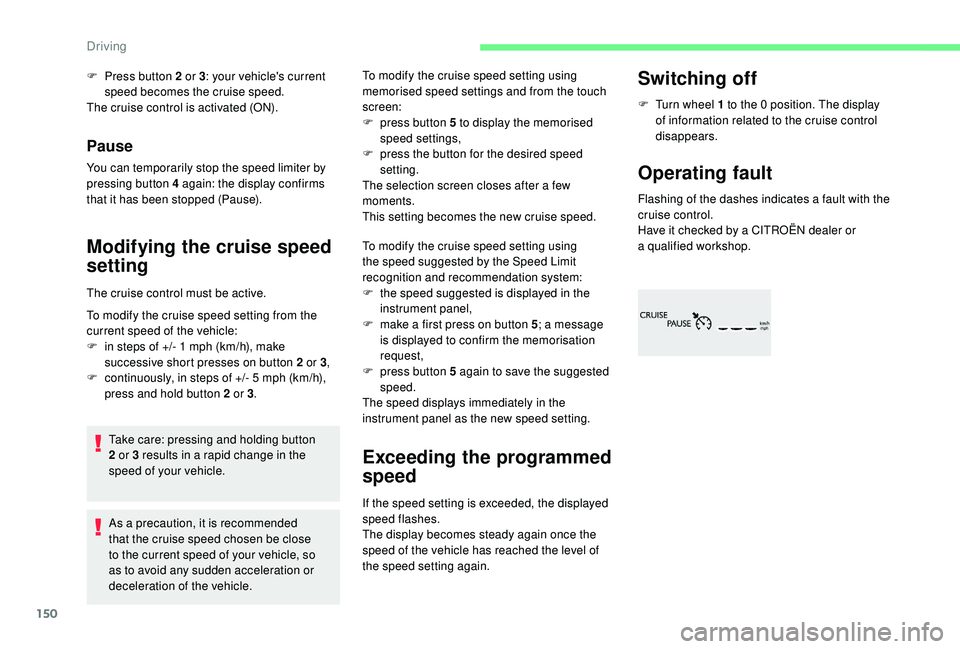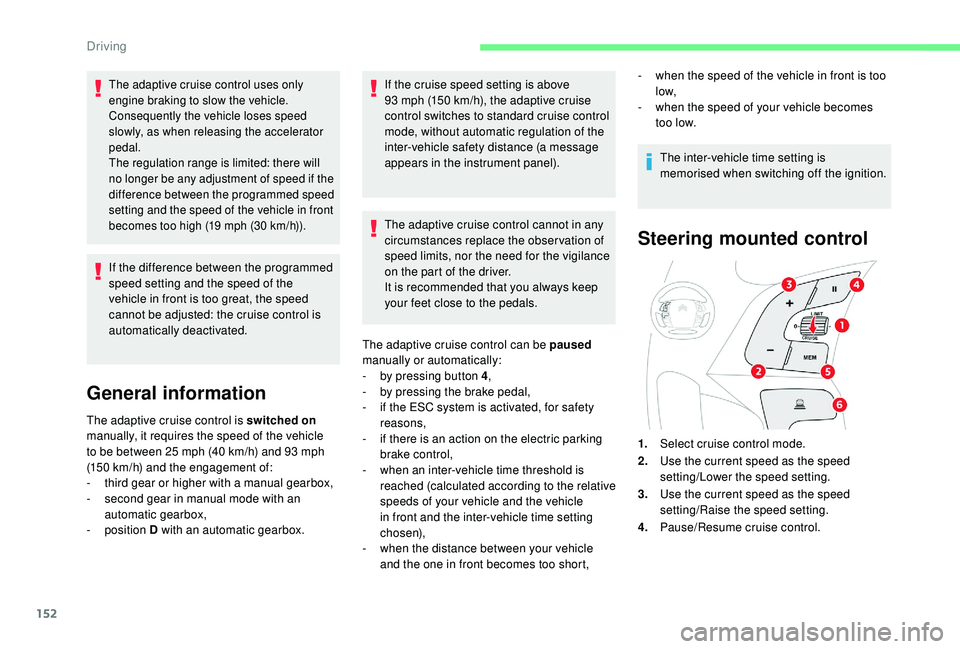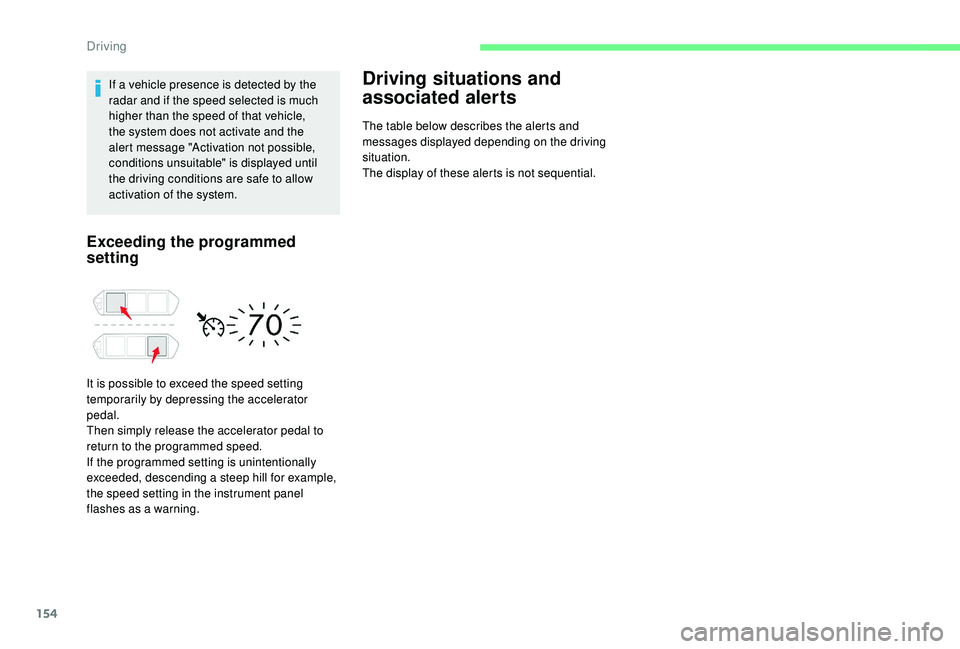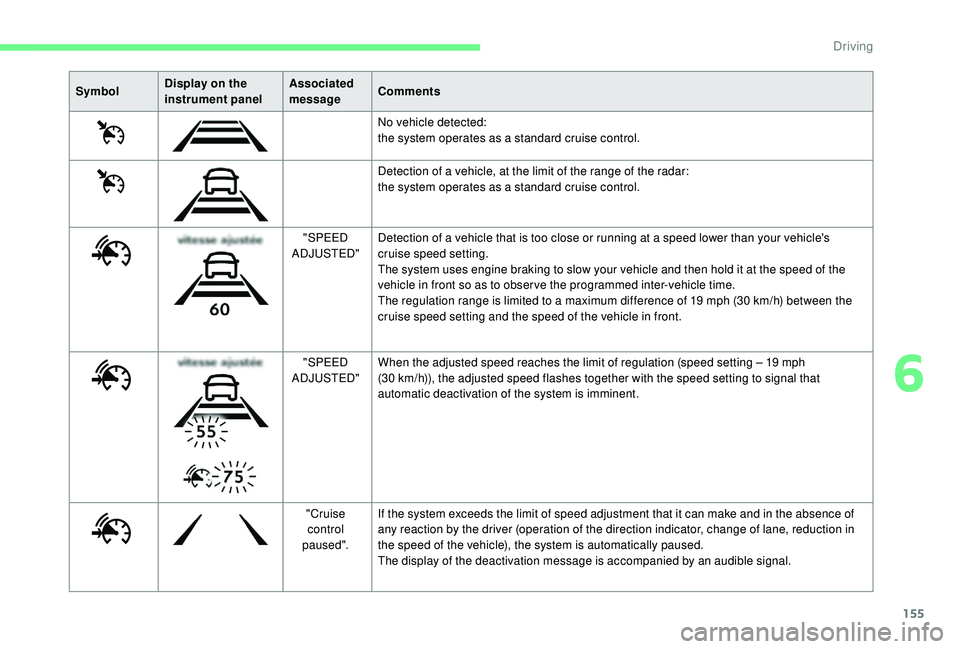CITROEN C4 PICASSO 2017 Owners Manual
Manufacturer: CITROEN, Model Year: 2017, Model line: C4 PICASSO, Model: CITROEN C4 PICASSO 2017Pages: 316, PDF Size: 10.36 MB
Page 151 of 316

149
Operation of the cruise control requires
a vehicle speed of at least 25 mph (40 km/h).
As well as engagement:
-
o
f third gear or higher with a manual
gearbox,
-
o
f second gear or higher in manual mode
with an automatic gearbox,
-
o
f position D with an automatic gearbox.
The cruise control is paused manually by
pressing button 4
or pressing the brake pedal
or if the ESC system is invoked for safety
reasons.
It is possible to exceed the programmed speed
temporarily by depressing the accelerator
pedal.
To return to the programmed speed, simply
release the accelerator pedal until the
programmed cruise speed is reached again.
Switching off the ignition cancels any
programmed speed setting.
The cruise control system cannot, in any circumstances,
replace the need to obser ve speed limits, nor can it
replace the need for vigilance on the part of the driver.
It is recommended that you always keep your feet close
to the pedals.
Steering mounted controlsDisplays in the instrument panel
6.Cruise control pause/resume indication.
7. Cruise control selection indication.
8. Value of the speed setting.
For more information on Memorising speeds ,
refer to the corresponding section.
For more information on Speed Limit
recognition and recommendation and its
memorisation, refer to the corresponding
section.
Switching on
F Turn wheel 1 to the CRUISE position: cruise
control mode is selected but the function is
paused.
1.
Select cruise control mode.
2. Set the current speed as the cruise speed
setting/Reduce the cruise speed setting.
3. Set the current speed as the cruise speed
setting/Increase the cruise speed setting.
4. Pause/Resume cruise control.
5. Display the list of memorised speeds or
Use the speed suggested by the sSpeed
Limit recognition and recommendation
system.
6
Driving
Page 152 of 316

150
Pause
You can temporarily stop the speed limiter by
pressing button 4 again: the display confirms
that it has been stopped (Pause).
Modifying the cruise speed
setting
The cruise control must be active.
To modify the cruise speed setting from the
current speed of the vehicle:
F
i
n steps of +/- 1 mph (km/h), make
successive short presses on button 2
or 3,
F
c
ontinuously, in steps of +/- 5 mph (km/h),
press and hold button 2
or 3.
Take care: pressing and holding button
2
or 3 results in a rapid change in the
speed of your vehicle.
As a
precaution, it is recommended
that the cruise speed chosen be close
to the current speed of your vehicle, so
as to avoid any sudden acceleration or
deceleration of the vehicle.
F
P
ress button 2 or 3
: your vehicle's current
speed becomes the cruise speed.
The cruise control is activated (ON). To modify the cruise speed setting using
memorised speed settings and from the touch
screen:
F
p
ress button 5 to display the memorised
speed settings,
F
p
ress the button for the desired speed
setting.
The selection screen closes after a few
moments.
This setting becomes the new cruise speed.
To modify the cruise speed setting using
the speed suggested by the Speed Limit
recognition and recommendation system:
F t he speed suggested is displayed in the
instrument panel,
F
m
ake a first press on button 5; a message
is displayed to confirm the memorisation
request,
F
p
ress button 5 again to save the suggested
speed.
The speed displays immediately in the
instrument panel as the new speed setting.
Exceeding the programmed
speed
If the speed setting is exceeded, the displayed
speed flashes.
The display becomes steady again once the
speed of the vehicle has reached the level of
the speed setting again.
Switching off
F Turn wheel 1 to the 0 position. The display
of information related to the cruise control
disappears.
Operating fault
Flashing of the dashes indicates a fault with the
c ruise control.
Have it checked by a
CITROËN dealer or
a
qualified workshop.
Driving
Page 153 of 316

151
When the cruise control is switched on, be
careful if you maintain the pressure on one
of the programmed speed modification
buttons: this may result in a very rapid
change in the speed of your vehicle.
Do not use the cruise control on slippery
roads or in heavy traffic.
When descending a
steep hill, the cruise
control system cannot prevent the vehicle
from exceeding the programmed speed.
On steep climbs or when towing, the
programmed speed may not be reached
or maintained.
The use of mats not approved by
CITROËN may inter fere with the operation
of the cruise control.
To avoid any risk of jamming of the pedals:
-
e
nsure that mats are secured correctly,
-
n
ever fit one mat on top of another.Adaptive cruise control
The system allows the speed of
your vehicle to be maintained at the
setting you have made, and also to
respect the inter-vehicle time that
you have selected between your
vehicle and the one in front, when
the situation permits it.
Switching between the
types of cruise control
The choice between "adaptive" and "standard"
cruise control is made in the Driving menu.
F
T
urn the cruise control wheel to
the "CRUISE" position.
F
I
n the Driving menu, select the Driving
functions tab and then Active cruise
control to activate or deactivate adaptive
cruise control.
For more information on the Cruise
control , refer to the corresponding
section.
Principles of operation
Using radar with a range of about 100 metres,
l ocated at the front of the vehicle, this system
detects a
vehicle travelling in front of your
vehicle.
It automatically adapts the speed of your
vehicle to that of the vehicle in front.
If the vehicle in front is travelling more slowly,
the system progressively reduces the speed of
your vehicle using just engine braking (as if the
driver had pressed the " -" b u t to n).
If your vehicle is too close to the vehicle in
front or is approaching it too quickly, adaptive
cruise control is automatically deactivated.
The driver is then alerted by an audible signal
accompanied by a
message.
If the vehicle in front accelerates or changes
lane, the adaptive cruise control gradually
accelerates your vehicle to return to the
programmed speed.
If the driver operates the direction indicator to
the left (left-hand drive) or to the right (right-
hand drive), to overtake a
slower vehicle, the
adaptive cruise control allows your vehicle to
temporarily approach the vehicle in front to
assist the overtaking manoeuvre, though never
exceeding the programmed speed.
The adaptive cruise control operates
by day and at night, in fog or moderate
rainfall.
6
Driving
Page 154 of 316

152
The adaptive cruise control uses only
engine braking to slow the vehicle.
Consequently the vehicle loses speed
slowly, as when releasing the accelerator
pedal.
The regulation range is limited: there will
no longer be any adjustment of speed if the
difference between the programmed speed
setting and the speed of the vehicle in front
becomes too high (19 mph (30 km/h)).
If the difference between the programmed
speed setting and the speed of the
vehicle in front is too great, the speed
cannot be adjusted: the cruise control is
automatically deactivated.
General information
The adaptive cruise control is switched on
manually, it requires the speed of the vehicle
to be between 25
mph (40 km/h) and 93 mph
(150
km/h) and the engagement of:
-
t
hird gear or higher with a manual gearbox,
-
s
econd gear in manual mode with an
automatic gearbox,
-
position D with an automatic gearbox. If the cruise speed setting is above
93
mph (150 km/h), the adaptive cruise
control switches to standard cruise control
mode, without automatic regulation of the
inter-vehicle safety distance (a message
appears in the instrument panel).
The adaptive cruise control cannot in any
circumstances replace the obser vation of
speed limits, nor the need for the vigilance
on the part of the driver.
It is recommended that you always keep
your feet close to the pedals.
The adaptive cruise control can be paused
manually or automatically:
-
b
y pressing button 4
,
-
b
y pressing the brake pedal,
- i f the ESC system is activated, for safety
reasons,
-
i
f there is an action on the electric parking
brake control,
-
w
hen an inter-vehicle time threshold is
reached (calculated according to the relative
speeds of your vehicle and the vehicle
in front and the inter-vehicle time setting
chosen),
-
w
hen the distance between your vehicle
and the one in front becomes too short, The inter-vehicle time setting is
memorised when switching off the ignition.
Steering mounted control
- when the speed of the vehicle in front is too
low,
-
w
hen the speed of your vehicle becomes
too low.
1. Select cruise control mode.
2. Use the current speed as the speed
setting/Lower the speed setting.
3. Use the current speed as the speed
setting/Raise the speed setting.
4. Pause/Resume cruise control.
Driving
Page 155 of 316

153
Displays on the instrument
panel
Information is grouped together on the
instrument panel.
Operation
Switching on
Adaptive cruise control must be selected in the
Driving menu.
F
T
urn wheel 1 to the "CRUISE " position:
cruise control mode is selected but the
function is paused.
F
P
ress one of the buttons 2 or 3: the current
speed of your vehicle becomes the cruise
speed setting.
The cruise control is activated (ON).
By default, the inter-vehicle time is set at
2
seconds.
Other wise, the last setting made will be used
when switching on the system.
Modification of the cruise speed
F choose a speed setting: it is displayed on
the instrument panel.
The selection screen closes after a
few
moments. The modification is then accepted.
-
b
y pressing button 5 , if your vehicle is
equipped with speed limit recognition:
F
t
he speed to be memorised appears on
the instrument panel.
F
press button 5
again to save the speed.
The value appears immediately on the
instrument panel.
For more information on Speed Limit
recognition and recommendation and its
memorisation, refer to the corresponding
section.
As a
precaution, it is recommended that
you select a
cruise speed setting close to
the current speed of your vehicle.
Changing the inter-vehicle
distance
Press button 6 to select a new inter-vehicle
d istance setting from the three levels (" Close",
" Normal ", "Distant ").
This setting remains memorised, whatever the
state of the system.
5.
Display the list of memorised speeds or,
Use the speed suggested by the Speed
Limit recognition and recommendation
system.
6. Display and adjustment of the
programmed inter-vehicle distance.
For more information on Memorising speeds ,
refer to the corresponding section.
For more information on Speed Limit
recognition and recommendation and its
memorisation, refer to the corresponding
section.
7. Cruise control pause/resume indication.
8. Cruise control selection indication, or
vehicle speed adjustment phase. 9.
Value of the programmed speed or
adjusted speed below the programmed
speed.
-
u
sing buttons 2
or 3:
F
b
y successive short presses, to change
in steps of + or – 1
mph (km/h),
F
b
y a
maintained press, to change in steps
of + or – 5
mph (km/h).
-
p
ressing button 5 :
F
t
he six speeds memorised are displayed
in the touch screen,
6
Driving
Page 156 of 316

154
If a vehicle presence is detected by the
r adar and if the speed selected is much
higher than the speed of that vehicle,
the system does not activate and the
alert message "Activation not possible,
conditions unsuitable" is displayed until
the driving conditions are safe to allow
activation of the system.
Exceeding the programmed
setting
It is possible to exceed the speed setting
temporarily by depressing the accelerator
pedal.
Then simply release the accelerator pedal to
return to the programmed speed.
If the programmed setting is unintentionally
exceeded, descending a
steep hill for example,
the speed setting in the instrument panel
flashes as a
warning.
Driving situations and
associated alerts
The table below describes the alerts and
messages displayed depending on the driving
situation.
The display of these alerts is not sequential.
Driving
Page 157 of 316

155
SymbolDisplay on the
instrument panel Associated
message
Comments
No vehicle detected:
the system operates as a
standard cruise control.
Detection of a
vehicle, at the limit of the range of the radar:
the system operates as a
standard cruise control.
"SPEED
ADJUSTED" Detection of a
vehicle that is too close or running at a speed lower than your vehicle's
cruise speed setting.
The system uses engine braking to slow your vehicle and then hold it at the speed of the
vehicle in front so as to obser ve the programmed inter-vehicle time.
The regulation range is limited to a
maximum difference of 19 mph (30 km/h) between the
cruise speed setting and the speed of the vehicle in front.
"SPEED
ADJUSTED" When the adjusted speed reaches the limit of regulation (speed setting – 19
mph
(30
km/h)), the adjusted speed flashes together with the speed setting to signal that
automatic deactivation of the system is imminent.
"Cruise control
paused". If the system exceeds the limit of speed adjustment that it can make and in the absence of
any reaction by the driver (operation of the direction indicator, change of lane, reduction in
the speed of the vehicle), the system is automatically paused.
The display of the deactivation message is accompanied by an audible signal.
6
Driving
Page 158 of 316

156
The adaptive cruise control uses only engine
braking to slow the vehicle. Consequently the
vehicle loses speed slowly, as when releasing
the accelerator pedal.
The system is paused automatically:
-
i
f the vehicle in front slows down too much
or too suddenly, and the driver does not
brake,
-
i
f a vehicle comes between your vehicle and
the vehicle in front.
The regulation range is limited to a maximum
d ifference of 19 mph (30 km/h) between the
cruise speed setting and the speed of the
vehicle in front. Above this, the system goes into
pause if the safety distance becomes too short.
Poor weather conditions (very heavy
rain, accumulation of snow in front of the
radar) may hinder the operation of the
system, with the display of the operating
fault message "SYSTEM INACTIVE:
Reduced visibility". The function remains
unavailable until the message disappears.
Since the radar detection range is relatively
narrow, it is possible that the system cannot
detect:
-
v
ehicles of reduced width, such as
motorcycles, for example, -
v
ehicles not running in the middle of the
lane,
When the adaptive cruise control is
automatically paused, it can only be
reactivated when safe conditions are
restored. The message "Activation
not possible, conditions unsuitable"
is displayed while reactivation is not
possible.
When the conditions allow, it is
recommended that the function be
reactivated by pressing button 2
or 3,
which will make the current speed of your
vehicle the new cruise speed setting,
rather than by pressing button 4 (on /
pause) which reactivates the cruise control
using the old cruise speed setting, which
may be very different from the current
speed of your vehicle.
Operating limits
- if the system does not slow the vehicle enough to continue to maintain a safe
distance, for example when descending
a
steep hill.
-
v
ehicles entering a
corner,
-
v
ehicles changing lane at the last moment.
The cruise control does not take account of:
-
s
tationary vehicles,
-
v
ehicles driving in the opposite direction.
Malfunction
In the event of a malfunction of the adaptive
c ruise control system, you are warned by an
audible signal and the display of the message
"Driving aid functions fault".
Have the system checked by a
CITROËN
dealer or a
qualified workshop.
Driving
Page 159 of 316

157
When the cruise control is working, take
care if keeping pressed one of the cruise
control programmed speed change
buttons: this can lead to a very rapid
change in the speed of your vehicle.
Do not use adaptive cruise control on
slippery sur faces or in heavy traffic.
When descending a
steep hill, the cruise
control system cannot prevent the vehicle
from exceeding the programmed speed.
On steep climbs or when towing, the
programmed speed may not be reached
or maintained.
The use of mats not approved by
CITROËN may inter fere with the operation
of the cruise control.
To avoid any risk of jamming of the pedals:
-
e
nsure that mats are secured correctly,
-
n
ever fit one mat on top of another. Operation of the radar, located in the
front bumper, may be impaired by the
accumulation of dirt (dust, mud, etc.) or in
certain weather conditions (snow, frost,
e t c .) .
The message "SYSTEM INACTIVE:
Reduced visibility". is displayed to indicate
that the function is in standby.
Clean the front bumper regularly.
If the front bumper is to be repainted or
retouched, contact a
CITROËN dealer
or a
qualified workshop. Certain types of
paint could inter fere with the operation of
the radar.
Adaptive cruise control
until vehicle is stopped/
until 19
mph (30 km/h)
Function until vehicle is stopped : with
automatic gearbox
Function until 19
mph (30 km/h): with manual
gearbox This system provides the following
functions:
-
A
utomatically maintains the
vehicle at the speed set by the
driver.
-
A
utomatic adjustment of the
distance between your vehicle
and the one in front.
Cruise control remains active after
changing gear regardless of the gearbox
type.
It manages the acceleration and deceleration
of the vehicle by automatically acting on the
engine and the braking system. With an automatic gearbox, automatic
adjustment of the distance can cause your
vehicle to come to a complete stop.
For this purpose there is a radar installed in the
front bumper.
6
Driving
Page 160 of 316

158
Primarily designed for driving on main
roads and motor ways, this system only
works on moving vehicles, driving in the
same direction as your vehicle.
Principle of operation
The system automatically adapts the speed of
your vehicle to that of the vehicle in front, to
maintain a
constant distance.
If the vehicle in front is driving more slowly, the
system slows or even stops your vehicle, using
engine braking and the braking system (for
versions fitted with an automatic gearbox).
If the vehicle in front accelerates or changes
lane, the cruise control progressively
accelerates your vehicle to return to the
programmed speed.
If the driver operates a
direction indicator to
overtake a
slower vehicle, the cruise control
allows your vehicle to temporarily approach
the vehicle in front to assist the overtaking
manoeuvre, though never exceeding the
programmed speed.
The brake lamps illuminate as soon as
the braking system is activated with
deceleration of the vehicle. This system is a
driving aid that cannot,
in any circumstances, replace the need to
obser ve speed limits and safety distances,
nor the need for vigilance on the part of
the driver.
Some vehicles present on the road may
not be properly seen or may be poorly
interpreted by the camera and/or radar
(e.g. a lorry), which may lead to a poor
assessment of the distances and lead to
the vehicle inappropriately accelerating or
braking.
The driver must be ready at all times
to retake control of their vehicle by
permanently holding both hands on the
steering wheel and keeping their feet near
the brake and accelerator pedals.
Steering mounted control
1. Select cruise control mode. 2.
Use the current speed as the speed
setting/decrease the speed setting.
3. Use the current speed as the speed
setting/increase the speed setting.
4. Pause/Resume cruise control.
5. Use the speed suggested by the Speed
Limit recognition and recommendation.
6. Display and adjustment of the
programmed inter-vehicle distance.
For more information on the Speed Limit
recognition and recommendation , refer to
the corresponding section.
Displays in the instrument
panel
7. Indication of the presence/absence of
a
target vehicle.
8. Indication of cruise control activation/
deactivation.
9. Value of the speed setting.
Driving